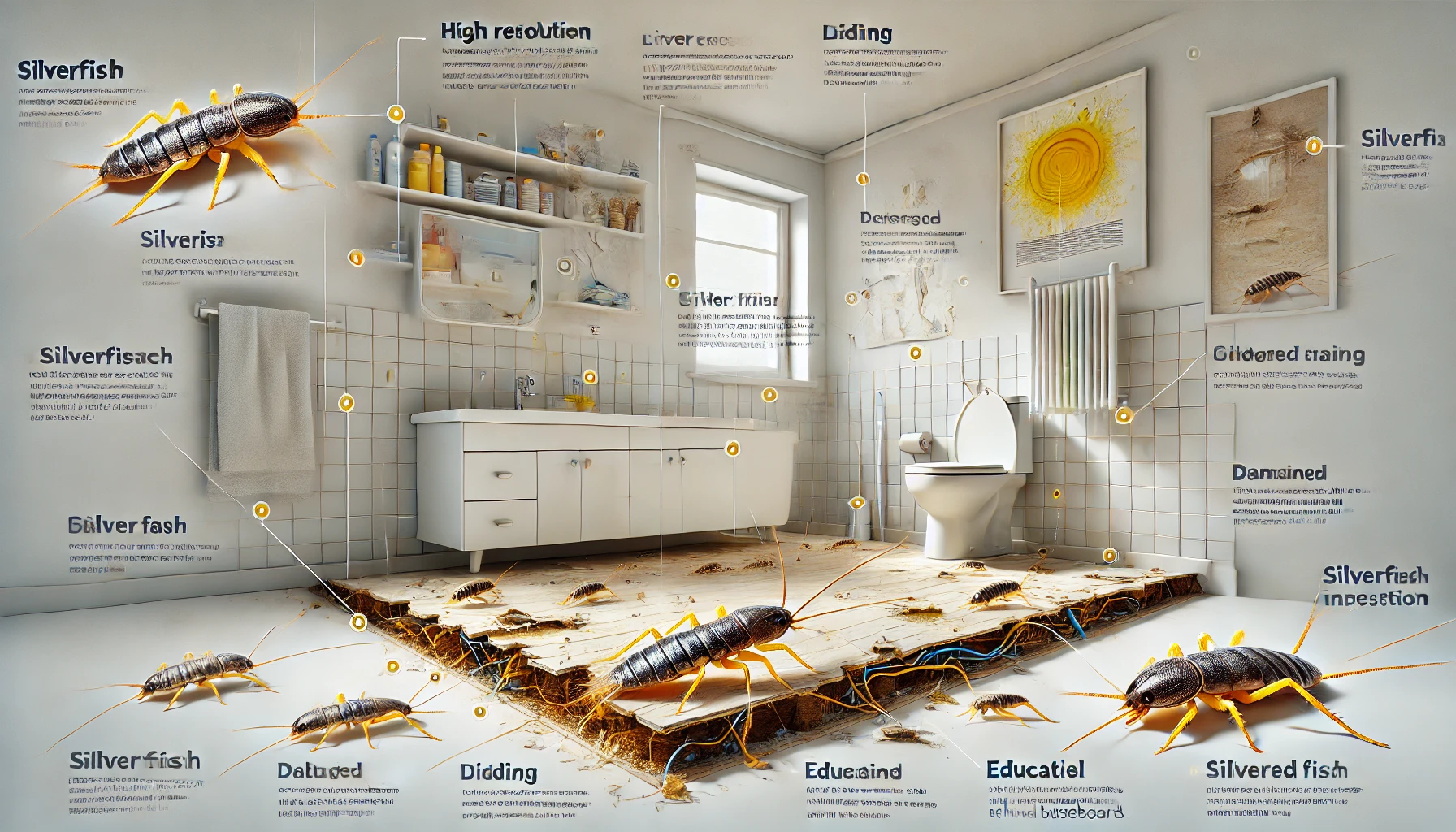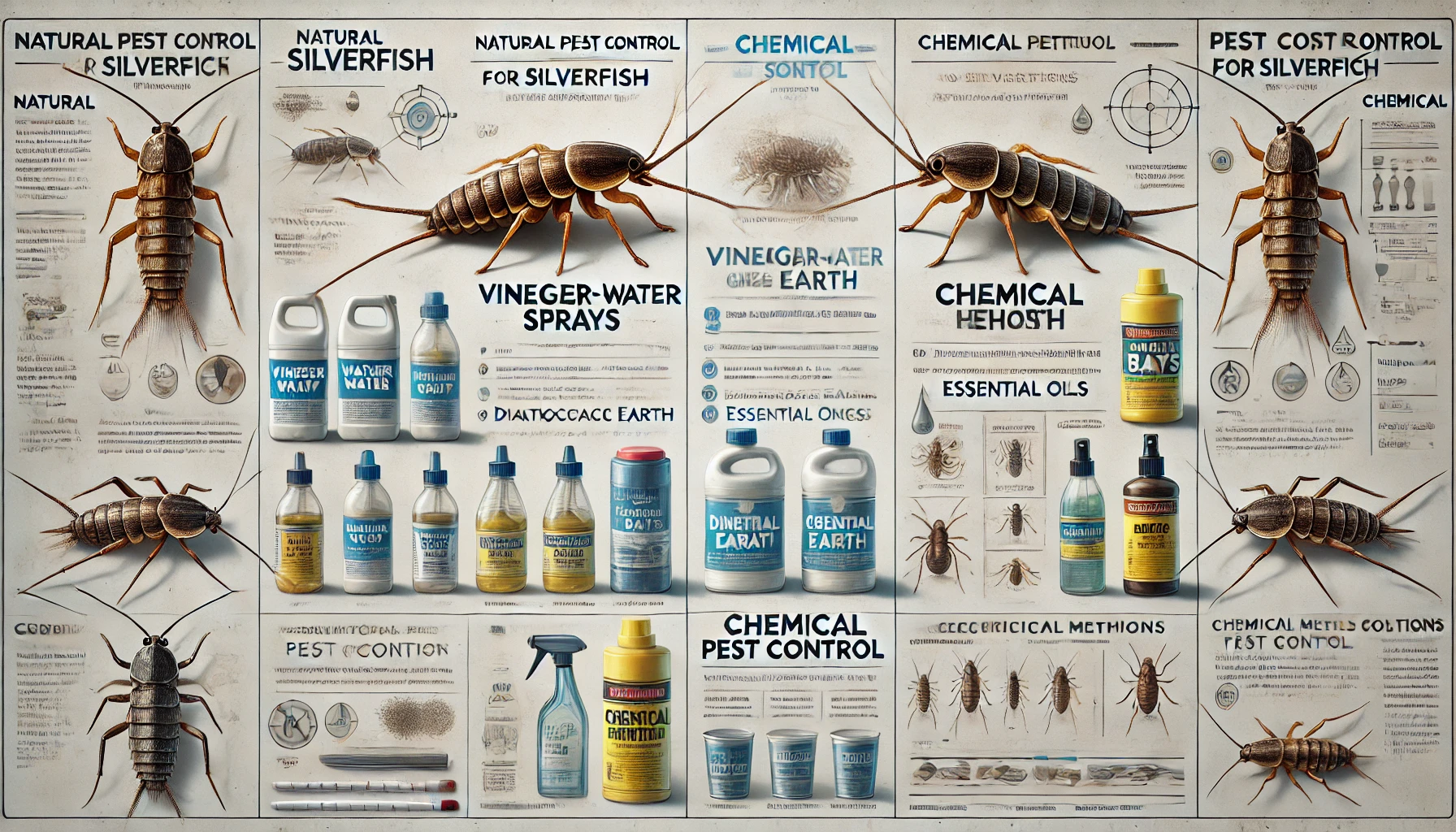Key Takeaways
-
Humidity Control: Silverfish thrive in humid environments, so use dehumidifiers and improve ventilation to reduce moisture in your home.
-
Eliminate Food Sources: Properly store food and reduce clutter to make your home less appealing to silverfish.
-
Seal Entry Points: Inspect your home for cracks and crevices and seal them to prevent silverfish from entering.
-
Traps and Baits: Use sticky traps or homemade baited traps to monitor and reduce silverfish populations.
-
Natural and Chemical Treatments: Utilize natural repellents like diatomaceous earth and essential oils, or use chemical insecticides for more severe infestations.
-
Regular Cleaning: Maintain a clean environment to prevent silverfish from thriving in your home. Regular vacuuming and dusting will keep them at bay.
 Silverfish (Lepisma saccharina) are those sneaky little pests that can make themselves available at your home without you even realizing it—until your favorite book starts falling apart, or your clothes get shredded. Their silvery, fish-like movements make them pretty hard to spot, and , to be honest hey’re one of those pests you overlook until they’ve already done some damage.
Silverfish (Lepisma saccharina) are those sneaky little pests that can make themselves available at your home without you even realizing it—until your favorite book starts falling apart, or your clothes get shredded. Their silvery, fish-like movements make them pretty hard to spot, and , to be honest hey’re one of those pests you overlook until they’ve already done some damage.
They like dark, humid spots, which is why basements, bathrooms, and even kitchens are their favorite hangouts. But here’s the thing: Once you know how to spot the signs of a silverfish infestation, you’ll be much better prepared to deal with it.
This detailed guide is all about helping you take control of those little invaders, so let’s break down how to tackle the problem head-on.
What Are Silverfish and Why Should You Care?
You’ve probably seen them scurrying across the floor at night—or maybe you’ve found them munching on that old book you thought was safe. Silverfish aren’t just a minor annoyance—they can cause real damage to your belongings. Think about it: they’re little paper-eating, fabric-chewing machines. They love to feast on materials that have starch or sugars in them—books, clothing, wallpaper, and even food. Yeah, you heard that right. They can even snack on your cereal.These pests are also long-lived, with some surviving for up to eight years. That means if you don’t prevent them quickly, your silverfish problem can stick around for a while. But don’t panic; they’re not dangerous to humans in the same way, say, a bee sting might be. They won’t bite or sting, but their ability to destroy things you value is what makes them a serious problem.

Signs of a Silverfish Infestation
If you’ve been wondering, “Hey, is that silverfish I just saw in the corner?” it’s time to check for a few other signs. Silverfish are sneaky little things, and they’re experts at hiding in plain sight. But don’t worry, they leave clues. 1. You Spot Them—Probably at Night Silverfish are primarily nocturnal, so you’ll rarely catch them during the day. If you see one, it’s a clear sign you’ve got a problem. They’re fast, and they scurry away quickly when you try to get a closer look, but you can catch them in action if you leave the lights off and peek around. 2. You Notice the Damage They love to munch on paper and fabrics—books, wallpaper, clothing—if it’s made of starch or glue, it’s fair game. You’ll notice tiny holes, yellow stains, or jagged edges on your favorite books and papers. You know that favorite shirt you’ve had for years? They might target it, too. 3. Silverfish Droppings Silverfish droppings are small, black, and look kind of like peppercorns. If you spot these near your bookshelves, food, or other items, chances are you’ve got a few silverfish moving in. 4. Shedding Skin As silverfish grow, they shed their exoskeletons. If you find small, translucent skins near the affected areas, you’ve probably got a breeding ground nearby.Effective Treatment Methods for Silverfish Control
Now that you know what you’re up against, let’s talk about how to deal with silverfish once they’ve made themselves comfortable in your home. The good news is, there’s a range of solutions you can try, from simple DIY methods to more professional treatments if things get out of hand.1. Lower the Humidity—Silverfish Love Moisture
- Here’s a pro tip: If you can control the humidity in your home, you can control silverfish. They love humidity levels above 75%, so if you want to make your home less inviting, keep things dry.
-
Use Dehumidifiers: A good dehumidifier helps keep moisture levels down, especially in damp areas like the basement or bathroom.
-
Fix Leaks: Fix any leaks around pipes or windows. Silverfish thrive in damp, dark places, so repairing leaks removes their favorite hiding spots.
-
Ventilate: Ensure good air circulation in rooms where moisture tends to build up. Open windows or use fans to keep things dry.
2. Remove Their Food Sources
- You know what silverfish love? Food. They’ll munch on your paper, clothing, and even dry foods if they can get to them. By making your home less inviting, you can drastically reduce the likelihood of an infestation.
-
Store Food Properly: Always store dry foods (cereal, flour, rice) in airtight containers. If silverfish can’t get to it, they won’t stay around.
-
Declutter: Silverfish thrive in cluttered areas. Get rid of old papers, cardboard boxes, and unused fabrics to limit their hiding spots.
3. Seal Entry Points—Close the Doors to Pests
- Silverfish will slip through even the tiniest cracks to get inside your home. Make sure to seal them off. This is like locking the door to a burglar.
-
Inspect for Cracks: Go around your home and check for cracks in walls, windows, and doors. Seal these gaps with caulk to prevent silverfish from sneaking in.
-
Screen Vents and Windows: Install screens on vents and windows to keep pests from entering, especially in humid areas.
4. Use Traps—Catch Them in the Act
- Sometimes, it’s about getting a little help from traps. While these won’t necessarily wipe out an infestation, they can undoubtedly help you monitor it.
-
Sticky Traps: Place sticky traps in areas where you suspect silverfish are active. This helps monitor the infestation.
-
Baited Traps: A simple homemade trap like rolled-up wet newspaper can attract silverfish. Dispose of it after a few days.
5. Natural Remedies—Silverfish Don’t Like These Scents
- If you’re not a huge fan of applying chemicals, you’ll be happy to know that there are natural ways to repel silverfish.
-
Diatomaceous Earth: Sprinkle diatomaceous earth in cracks and crevices. This natural powder dries out silverfish’s exoskeleton, causing them to die on contact.
-
Essential Oils: Silverfish dislike the smell of cedarwood, lavender, and citrus. Use soaked cotton balls to place in active areas.
6. Chemical Treatments—If You Really Need Them
- Sometimes, when things are bad, you just need the big guns. If your silverfish problem is out of control, chemicals might be the answer.
-
Insecticides: Apply silverfish-specific insecticides to cracks and crevices. Be cautious around pets or children and always follow instructions.
-
Boric Acid: Apply boric acid to areas where silverfish are active. It poisons them when ingested, but be mindful of where you place it.
7. Regular Cleaning—Prevent Future Infestations
- Silverfish love a dirty home, so if you want to keep them away, regular cleaning is key.
-
Vacuum Regularly: Vacuum carpets, rugs, and upholstery to remove crumbs, dust, and silverfish eggs.
-
Dust and Wipe Down: Regularly wipe down shelves and baseboards to minimize food sources and discourage silverfish from sticking around.
 By following these strategies, you can effectively manage and control silverfish in your home. If the infestation persists despite your efforts, it may be time to consult a professional pest control service to help eliminate the problem.
By following these strategies, you can effectively manage and control silverfish in your home. If the infestation persists despite your efforts, it may be time to consult a professional pest control service to help eliminate the problem.
 If you feel things have gone out of control, it is advised to contact pest control professionals. Our team can provide a customized approach to protect your home effectively.
If you feel things have gone out of control, it is advised to contact pest control professionals. Our team can provide a customized approach to protect your home effectively.
Visit our Species, Control, and DIY Guide sections for additional resources on silverfish and ways to tackle a silverfish infestation.





